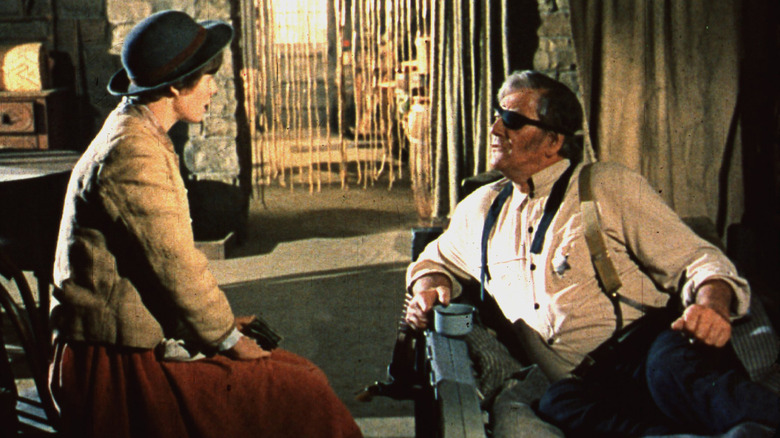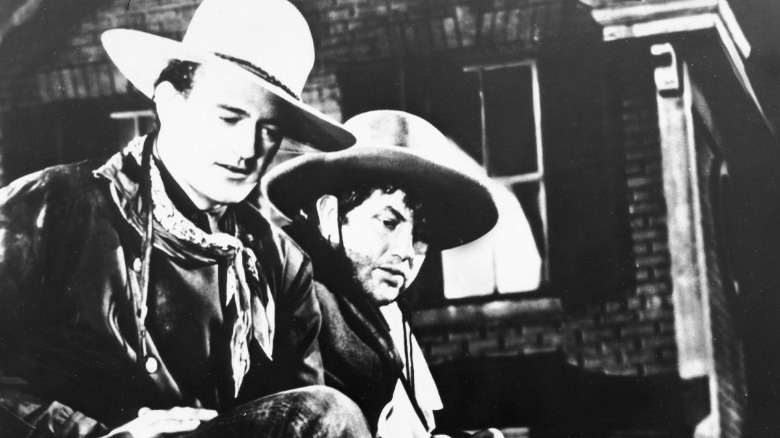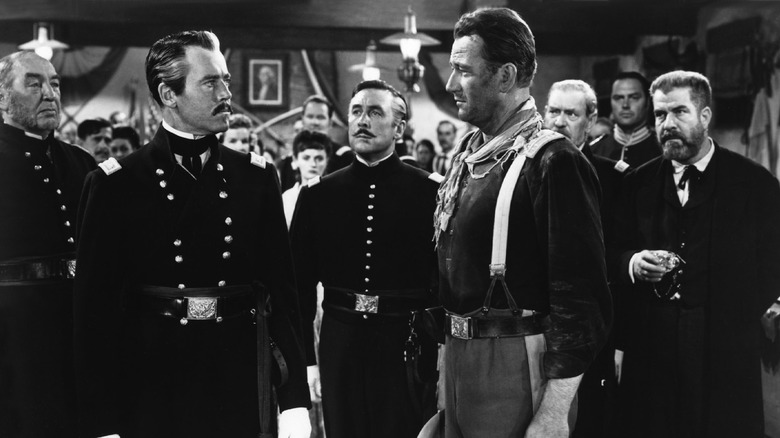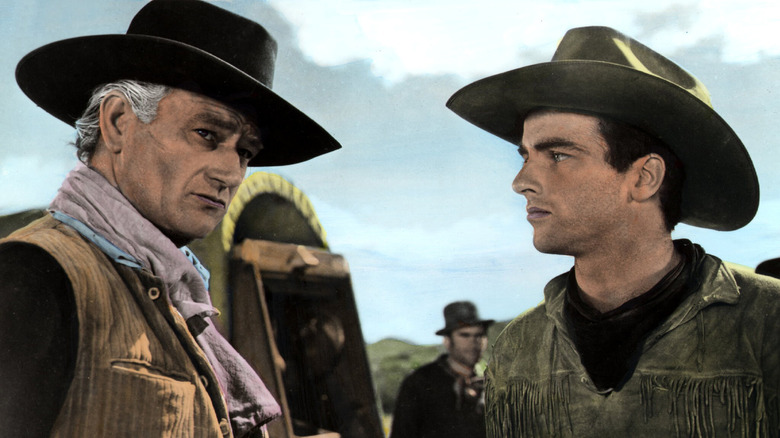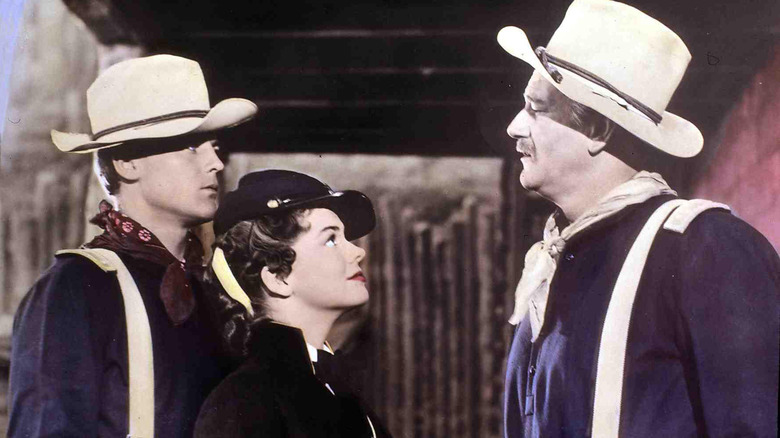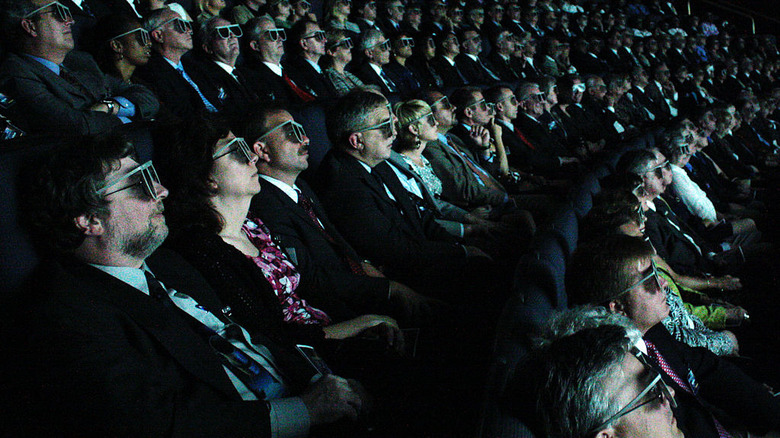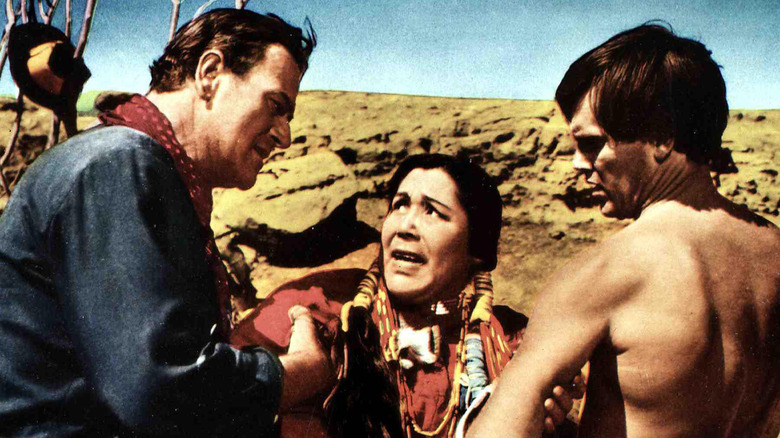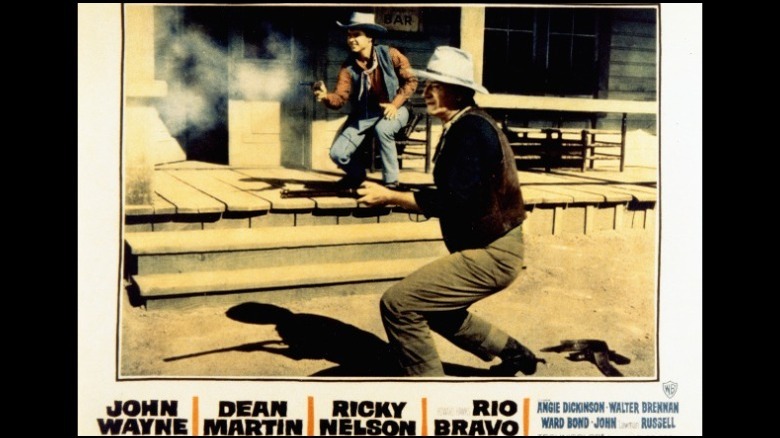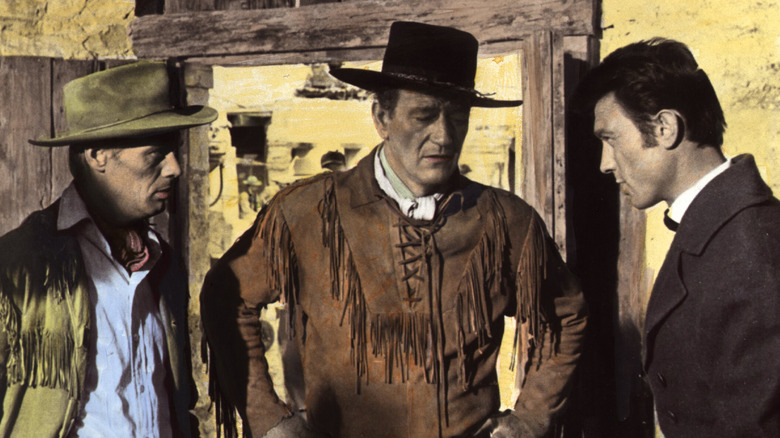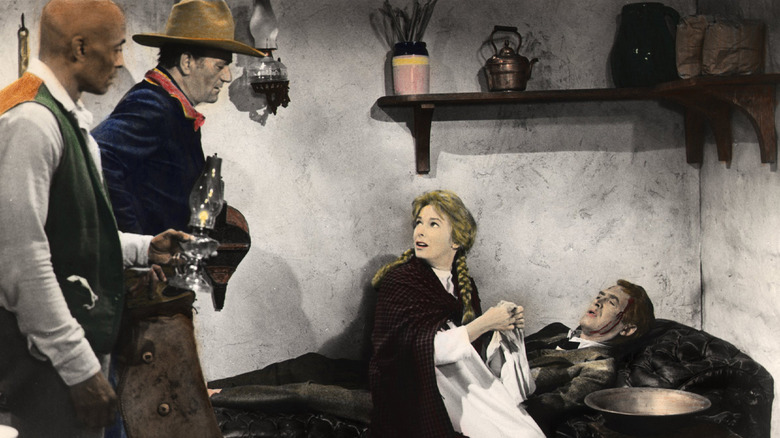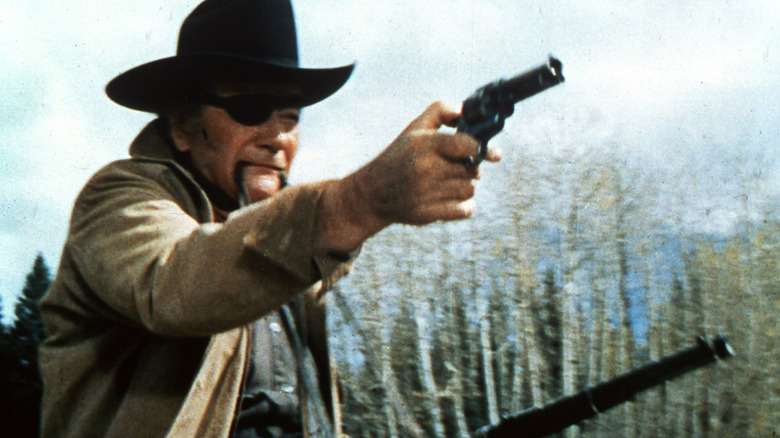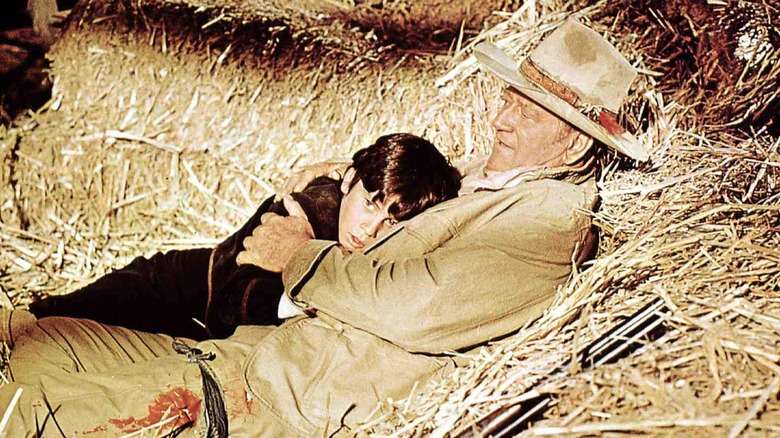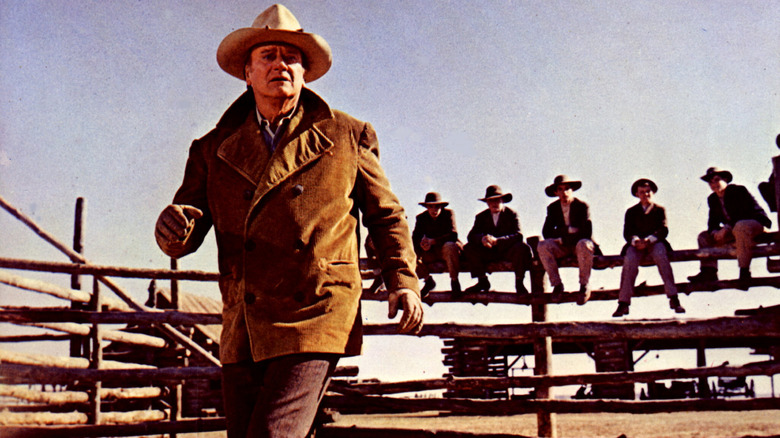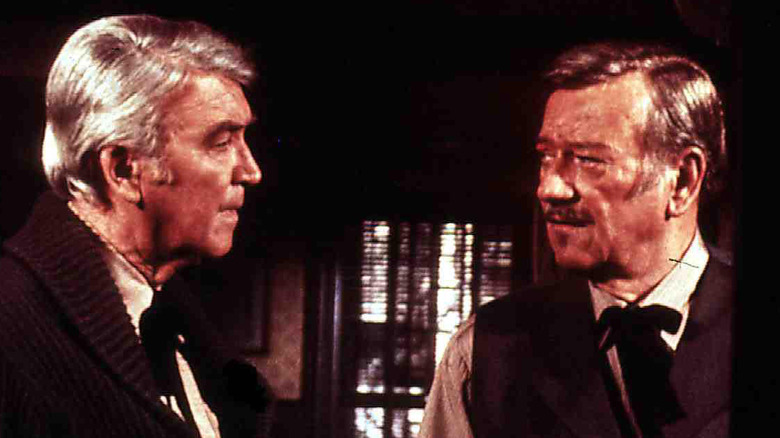The Best Westerns Starring John Wayne
We may receive a commission on purchases made from links.
"A man deserves a second chance," actor John Wayne once said, "but keep an eye on him." That particular quote is interesting for two reasons. For one, Wayne would never have been in the movies at all had a surfing accident at Newport Beach, California — at the infamous "Wedge," a prime but sometimes dangerous hotspot for surfers — not ruined his football career. The accident caused Wayne to lose his scholarship at the University of Southern California, after which he turned to working in the film industry. And two, America and even the world has kept a close eye on the man pretty much ever since he made his official movie debut in 1938, even well after his death in 1979.
Born Marion Morrison in 1907, Wayne moved to California at the age of 7 and was working in movies by 1926. Almost 200 films and 27 awards (including an Oscar for best actor) later, Wayne remains an icon in the film industry, especially for his work in western films. But which of John Wayne's westerns are the best? It's hard to say since everyone from the IMDB to Rotten Tomatoes has their own list. We've picked the best of the them from the best lists — read on for a compilation of John Wayne's best westerns.
Stagecoach was John Wayne's first movie
According to Outsider, in 1938, John Wayne spent a boating weekend with veteran director John Ford. Ford was mulling over the best actor to play the Ringo Kid in his newest movie, "Stagecoach." He asked Wayne to read the script and recommend a leading man, and Wayne suggested actor Lloyd Nolan. But the answer was unsatisfactory to Ford. By the end of the weekend he'd given the role to Wayne instead, who said the offer was like being "hit in the belly with a baseball bat."
Wayne turned out to be perfect for the part. The film is about a stagecoach traveling around the west with some mighty interesting passengers, including the Ringo Kid, who is in handcuffs after escaping from prison on a vendetta to avenge the murders of his father and brother. Miles Hood Swarthout, who wrote the screenplay for Wayne's last movie, "The Shootist," in 1976 described the scene in which the Ringo Kid is seen cocking his rifle while holding his saddle gear as "the moment the Duke is born." The film scored two Academy Awards, and Wayne was nominated for the best actor award at the Faro Island Film Festival. He would go on to make 13 more epic films with Ford through 1963.
Fort Apache was the first and best of John Ford's cavalry trilogy
In 1948, Wayne again teamed with John Ford on "Fort Apache" in the first of what is referred to the director's "cavalry trilogy" (the other two being "She Wore a Yellow Ribbon" and "Rio Grande"). Wayne starred as Captain Kirby York who must work under veteran actor Henry Fonda's Lt. Colonel Owen Thursday. The trouble is, Thursday's hatred of Native Americans doesn't set well with our hero. Another veteran co-star was none other than former child actress Shirley Temple, then aged 19, in her last major film role. Temple played Thursday's daughter (notably, Temple was married to her love interest in the film, John Agar. Ford incessantly "rode him mercilessly," calling him "Mr. Temple").
Trivia aside, Destination Hollywood says "Fort Apache" was based on the book "Massacre" by James Warner Bellah with a nod to General George Custer's death at Little Bighorn in 1876 and the Fetterman Massacre of 1866. Variety called "Fort Apache" a "masterfully combined" movie with "a superb musical score." The New York Times also applauded the film and Ford for "his rich blend of personality" among the characters and "the gorgeously picturesque outdoor western scenery." Today, the film is heralded for its social commentary on the morality of conflicts between American soldiers and Native Americans in the old west.
John Wayne broke out of his own stereotype in Red River
"Red River," also released in 1948, is often heralded as some of John Wayne's best work. His character, Thomas Dunson, is a "tyrannical cattle rancher" who must lead a cattle drive along the rough and difficult Chisholm Trail. When the going gets tough Dunson just gets tougher, having already lost his girl to an "Indian massacre" and killing others in land disputes. Unfortunately his pride often gets the best of him. Writer Geoffrey O'Brien, who commends Wayne for playing Dunson, was pleased to see him portray his character "without melodramatic exaggeration."
Deep Focus Review says that Wayne's work even stunned John Ford, who uttered the oft-quoted comment that "I never knew the big son of a b**** could act!" to "Red River" director Howard Hawks. It was the first time the actor actually delivered a complex, intense role, and led to Ford later giving him more demanding characters to play. Roger Ebert said that the moment where Dunson commands Matthew Garth (Montgomery Clift) to "Take 'em to Missouri, Matt!" with the resulting hoots and "Hee-yaws" from the cowboys as they set out was "as quintessentially Western as any ever filmed," although some John Wayne fans had a hard time seeing their hero's character let his own stubbornness get the best of him.
John Wayne played a much older character in She Wore a Yellow Ribbon
After watching John Wayne deliver his commanding performance in "Red River," John Ford stepped up the actor's game in 1949. The film was "She Wore A Yellow Ribbon," the second in the director's "cavalry trilogy," about an aging cavalryman who must evacuate some women as an impending "Indian attack" looms in the near future. Although Wayne's character, Nathan Brittles, was 20 years older than the actor, he played the role swimmingly. It was quite a switch, writes the San Francisco Chronicle's Carlos Valladares, from the "un-Wayne-like homicidal fire" seen in "Red River." And, it worked.
A 1949 New York Times review praised Wayne's performance as "the absolute image and ideal of the legendary cavalryman." No wonder even Wayne himself believed it was his best role, and Miles Hood Swarthout submits that it didn't hurt that Ford borrowed "colors and compositions" from the works of prolific western artist Frederick Remington for the backdrop scenery. The effort got cinematographer Winton C. Hoch an Academy Award. Trivia fact: Do You Remember says that during a stampede scene Wayne's horse threw him, knocking him out when he hit the ground. The unconscious actor might have been trampled by the oncoming horses had a wrangler not quickly jumped in front of him and waved the equines off.
Hondo showed John Wayne in 3D
Here's another fun trivia fact: John Wayne didn't just star in 1953's "Hondo," he also produced the movie. According to writers Bob Furmanek and Jack Theakston at 3-D Film Archive, "Hondo" received much acclaim as "one of 'the Duke's' finest independent achievements." But the real kicker is that the film actually showed in theaters in 3D. How did this happen? Little White Lies confirms that by the early 1950s, with home television purchases on the rise, movie theaters sought to boost ticket sales by introducing 3D cinema. Although many 3D films of the '50s fell into the horror genre, "Hondo" was actually released in more theaters than any other 3D movie.
There are other elements that also make this movie stand out. It was only the second feature film to be based on a novel — "The Gift of Cochise," by famed western writer Louis L'Amour. And Wayne's co-star, Geraldine Page, was so good in her first movie role that she was nominated (but did not win) an Academy Award for best actress –- which led Wayne to later snark, "She may have been great on Broadway, but she didn't know a damned thing about making movies!" Today, IMDB gives "Hondo" a solid 7.1 rating, and it has a metascore of 79, based on critic's reviews.
The Searchers explored a dark side of history
In 1868, Libby "Squirrel Tooth Alice" Haley was rescued after three years in captivity with the Native Americans who had kidnapped her. Her father, believing she was forever ruined, forbid her from marrying and later even shot her fiancé to death on the front porch to prove his point. What does this true story have to do with director John Ford's 1956 film "The Searchers"? John Wayne's character, Ethan Edwards, also must come to the rescue of a girl — his niece — after she is kidnapped by Native Americans. However, he plans to kill her because she is "no longer pure." The film is a "hard look at the darkness lurking beneath the genre" of western film, notes Gold Derby, and a bold commentary on history we would rather forget.
It was not easy for Wayne to play a killer. Co-star Harry Carey Jr. recalled how the serious gloom of the story on the set affected the cast and crew. "When I looked up at [Wayne] in rehearsal, "it was into the meanest, coldest eyes I had ever seen," the actor is reported as saying. Edwards was more racist and evil than any other character played by Wayne. Add some "astonishingly beautiful," scenery and what Roger Ebert considered some of Wayne's best work, and here is a film worth noting on several levels. The saddest part? Ebert also says that viewers in 1956 tended to go along with the movie's "harsh view of Indians."
Rio Bravo is a cult favorite among today's directors
Director Howard Hawks once again teamed up with John Wayne to make "Rio Bravo" in 1959. Golden Derby describes the story of local sheriff John T. Chance (Wayne), whose aimless buddies help him keep a murderer locked up as "the quintessential western." Surprisingly the public didn't like the film much, perhaps because co-star Dean Martin's work in comedy and Ricky Nelson's heartthrob status detracted from the movie's seriousness.
In the years since "Rio Bravo" came out, a handful of filmmakers that include John Carpenter, Martin Scorsese, and Quentin Tarantino, have come to regard the film as a true classic (John Travolta's Chili Palmer even paid a quick homage to it in the movie-making film "Get Shorty"). The movie rates a solid 8.0 on the IMDB, has a metascore of 93, and scored 100% in 42 reviews on Rotten Tomatoes. It was called one of the greatest films of all time by the British Film Institute. No wonder it made True West magazine's list of Wayne's best westerns.
The Alamo was John Wayne's idea
In 1960, Wayne propelled the retelling of the epic second battle at the Alamo of 1836. It was the second film of five films he directed and had been a "dream project" for some time, according to Britannica. At just over three hours long, "The Alamo" caught the unwavering eye of both audiences and the Academy Awards, earning seven nominations including one for best motion picture with Wayne as producer and one for Chill Wills for best actor in a supporting role. At the end of the evening, however, the film walked away with only an award for best sound.
If a New York Times review had anything to do with it, "The Alamo" might not have been nominated for anything at all. The review made fun of Wayne for daring to play Davy Crockett and propelling the notion that Crockett always wore a coonskin cap. Which raises the question of whether the movie was even a totally accurate history of the real story. In spite of diligent research for "The Alamo," a Shroud of Thoughts says that the "resulting film would be extraordinarily inaccurate" and not just because of Crockett's headwear. Although the movie's characters refer to the Rio Grande as being nearby, that river is actually over 150 miles to the west. At least the critics liked it.
The Man Who Shot Liberty Valance was deemed pensive and thoughtful
John Wayne made up for the historical inaccuracies of "The Alamo" by once again teaming with director John Ford and a host of popular actors (Lee Marvin, Vera Miles, and James Stewart) for "The Man Who Shot Liberty Valance" in 1962. The plot revolves around the memories of an aging senator comes to town and tells the story of Tom Doniphan (Wayne), who actually shot Valance, and Ranse Stoddard (Stewart) who was wrongfully accused of the deed. The movie is based on a fictional book by Dorothy M. Johnson, but Ford apparently went to great lengths to portray the west as accurately as possible.
The Harvard Crimson described the movie as "unmistakably the director's final statement on the West." As one of the last films Ford directed before he died in 1973, "The Man Who Shot Liberty Valance" was a love letter of sorts to his own career of showing audiences how the west was built, and how it eventually expired in the wake of modern society. The Baltimore Sun agrees, noting that the movie's famous quote, "When the legend becomes fact, print the legend," is poignant since Ford worked to make the story so accurate.
True Grit scored John Wayne his only Oscar win
In 1969's "True Grit," Wayne played the drunken, ornery yet brave and resolute Rooster Cogburn, a lawman hired by a precocious teen to avenge the killing of her father. Wayne, now in his 60s, aptly played Cogburn to the hilt, cussing on film for the first time and performing many of his own stunts. It didn't hurt that he had plenty of well-known co-stars too, including crooner Glen Campbell and actors Robert Duvall and Dennis Hopper. The movie was nominated for two Academy Awards including best actor, which Wayne won.
History explains that the Oscars had virtually ignored John Wayne and some of his best roles, such as those in "The Man Who Shot Liberty Valance," "Red River," "Stagecoach," and "The Searchers." In an interview with Roger Ebert, the actor himself explained that "It's sure as hell my first decent role in 20 years, and my first chance to play a character role instead of John Wayne." You bet Wayne deserved that Oscar, and just one look at the scene where he rides out, rifle in hand and reigns in his teeth tells us he's worth his salt. Also, his Rooster Cogburn was so endearing that he would later reprise character in 1975's "Rooster Cogburn," co-starring Katharine Hepburn.
Big Jake co-starred John Wayne's sons
"Big Jake" was interesting on two notes. For one, the movie was produced by John Wayne and his son Michael, and co-starred Wayne's other two sons: Ethan Wayne as grandson Jake McCandles Jr. and Patrick Wayne as Big Jake's son James (on a side note Jake's other son, Michael, was played by actor Robert Mitchum's son Christopher). The second note is that "Big Jake" was set in 1909, over 10 years after the Wild West era officially ended. Perhaps that is why Emanuel Levy called the film "a second rate western."
Western Classic Movies surmises that Hollywood's western genre was starting to change when "Big Jake" premiered in 1971. In order to keep up, the film was more violent than many of John Wayne's other films. "There is gore spattered all over the screen," complained Variety, saying that "A Wayne film doesn't have to resort to such excess." But the critic did say that the performances in the film were "very professional," and it is notable that this was one of Wayne's only films to give a nod to modern technology after the turn of 1900, and its affect on the dying west.
The Cowboys appealed to John Wayne lovers and teen fans alike
As Roger Ebert pointed out, 1972's "The Cowboys" violates the "western convention" of the time — the good guy (Wil Andersen, played by John Wayne) never even gets off a shot, and is killed by the bad guy. But this boys-to-men story about a cattle rancher forced to hire 11 children to help him get his cattle to market while being trailed by rustlers has much more to it. Movies and Drinks calls it exciting and emotional, and "one of Wayne's best," although some critics objected to the violence in the film.
There was another appeal to "The Cowboys," too. Of the 11 young actors in the film, several (including Robert Carradine, A. Martinez, and Stephen Hudis) went on to become heartthrobs, expanding the viewer audience of the film. Sure, the boys transformed into "remorseless killers" to avenge Andersen's murder, but the beauty of the film is how its story is "seen through the eyes" of those teens, and True West considers it one of Wayne's best films, even if actor Bruce Dern caught a lot of flack for killing off our hero.
The Shootist was John Wayne's last film and an ode to his career
As John Wayne's last film, "The Shootist" was indeed an "eloquent last hurrah" for the veteran actor. Like his character, J.B. Books, the elderly Wayne was dying of cancer. The first clue that the 1976 movie is a tribute of sorts comes in the opening credits, which show clips of Wayne's past movies. Books has been diagnosed by his doctor (Jimmy Stewart), and he wants to die quickly and with dignity. And in classic western Wayne style, he chooses death by gunfight.
Ranking at No. 3 on IMDB's list of John Wayne movies, "The Shootist" features Lauren Bacall as the widowed boardinghouse keeper who worries over Books and Ron Howard as her overly zealous, young ruffian son. The Outsider reveals that Howard was once taken aback by Wayne calling him a "bigshot," but managed to get into the actor's good graces by running lines with him for the film. It all worked out; even scriptwriter Miles Hood Swarthout had to admit that the shoot-out between Books and the bad guys "is a beaut."
